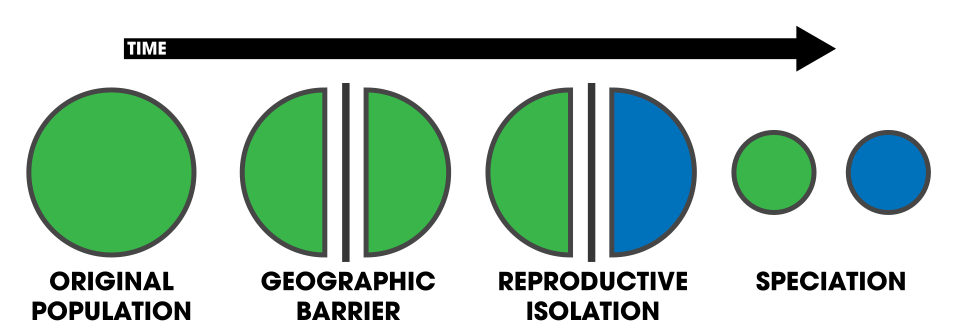OCR Specification focus:
‘Describe stabilising and directional selection, genetic drift, bottlenecks and founder effects, and explain how isolating mechanisms can drive speciation.’
Evolutionary forces act on genetic variation within populations, shaping species over generations. These processes influence allele frequencies, leading to adaptation, diversification, and the emergence of new species.
Evolutionary Forces and Their Effects
Natural Selection
Natural selection is the process by which individuals with advantageous traits survive and reproduce more successfully, increasing the frequency of beneficial alleles in a population. It operates on phenotypic variation, which arises from genetic and environmental differences.
There are several key types of natural selection that determine how traits evolve within populations.
Stabilising Selection
Stabilising selection favours intermediate phenotypes and acts against extremes. It maintains the existing population mean by reducing variation around it.
Occurs when environmental conditions are stable.
Reduces genetic diversity but maintains well-adapted traits.
Example: Human birth weight — very low or very high weights are less likely to survive, favouring average-sized infants.
This form of selection helps populations remain adapted to constant environments, promoting stability rather than change.
Directional Selection
Directional selection favours one extreme phenotype over the other, shifting the population mean in one direction.
Common during environmental change or when new selective pressures arise.
Results in evolutionary change as advantageous alleles become more frequent.
Example: Bacteria developing antibiotic resistance — resistant individuals survive and reproduce, increasing the proportion of resistance alleles.
Stabilising and directional selection can both operate at different times in the same population, depending on environmental conditions.
Disruptive Selection
Although not specifically required by the specification, disruptive selection is useful for context. It favours both extremes and can lead to the formation of distinct groups, often preceding speciation.
Genetic Drift and Random Evolutionary Change
Genetic Drift
Genetic drift is the random change in allele frequencies due to chance events, not natural selection. It has a greater effect in small populations, where random sampling of alleles can significantly alter the gene pool over generations.
Genetic Drift: Random changes in allele frequencies within a population, especially significant in small populations, due to chance rather than selective advantage.
Over time, genetic drift can reduce genetic variation and cause alleles to become fixed or lost, impacting a population’s ability to adapt to new environments.
The Bottleneck Effect
A population bottleneck occurs when a large population experiences a drastic reduction in size, often due to environmental catastrophes, disease, or human activity.
Surviving individuals may carry only a small fraction of the original genetic diversity.
When the population recovers, genetic variation remains low.
Reduced variation increases vulnerability to environmental changes and disease.
Bottleneck Effect: A sharp reduction in population size leading to loss of genetic diversity, caused by random survival rather than selective advantage.
An example includes cheetahs, which show low genetic variability due to historical population bottlenecks.

A population bottleneck occurs when most individuals are lost, leaving a small, unrepresentative sample. Subsequent generations inherit reduced diversity, so genetic drift has stronger effects. This diagram highlights how allele proportions can shift purely by chance during and after the bottleneck. Source.
The Founder Effect
The founder effect is a type of genetic drift that occurs when a small group of individuals colonises a new area, forming a new population.
The gene pool of the new population reflects only a subset of the original population’s alleles.
Certain alleles may become common purely by chance.
Can lead to rapid genetic divergence from the source population.
Founder Effect: The reduced genetic diversity that results when a new population is established by a small number of individuals from a larger population.
Examples include island populations or isolated human groups such as the Amish, where certain genetic conditions are more prevalent due to the founder effect.
Speciation and Isolating Mechanisms
What is Speciation?
Speciation is the process by which new species arise through the accumulation of genetic differences that prevent interbreeding between populations.
Speciation: The formation of new species when populations become reproductively isolated and diverge genetically over time.
Speciation requires reproductive isolation to prevent gene flow between populations.
Types of Reproductive Isolation
Prezygotic (Before Fertilisation)
Prevents mating or fertilisation between populations:
Temporal isolation – breeding seasons occur at different times.
Ecological isolation – populations occupy different habitats or niches.
Behavioural isolation – differences in courtship or mating behaviour prevent recognition.
Mechanical isolation – incompatible reproductive structures.
Gametic isolation – gametes are unable to fuse successfully.
Postzygotic (After Fertilisation)
Occurs when mating does occur but offspring are unviable or infertile:
Hybrid inviability – embryos fail to develop properly.
Hybrid sterility – hybrids are infertile, e.g. mule (horse × donkey).
Hybrid breakdown – offspring of hybrids are weak or sterile.
Allopatric and Sympatric Speciation
Speciation can occur through different geographical and ecological scenarios.
Allopatric speciation: Populations are geographically separated, preventing gene flow. Over time, mutations, natural selection, and genetic drift lead to divergence. When populations reunite, they may no longer interbreed.
Sympatric speciation: Occurs within the same geographical area, often due to reproductive isolation caused by polyploidy (in plants) or disruptive selection on specific traits.
Both mechanisms demonstrate how isolating processes can lead to the emergence of new, reproductively distinct species.

Allopatric speciation arises when a geographical barrier splits a population, preventing gene flow. Over time, divergent selection, drift and mutation lead to reproductive isolation and distinct species. The diagram uses simple map panels with arrows to emphasise the sequence from separation to speciation. Source.
Interactions Between Forces
Evolution is rarely driven by a single force. Instead, natural selection, genetic drift, bottlenecks, and founder effects interact continuously:
Natural selection shapes adaptation to the environment.
Genetic drift influences allele frequency by chance.
Bottlenecks and founder effects amplify drift by reducing diversity.
Isolating mechanisms ensure that genetic divergence can accumulate, leading to speciation.
These combined processes drive the dynamic, ongoing evolution of life on Earth.
FAQ
Disruptive selection favours individuals at both extremes of a phenotypic range, reducing the success of intermediate phenotypes.
Over time, this can create two distinct groups within the same population that specialise in different ecological niches.
If these groups experience reduced interbreeding — for example, due to behavioural or temporal isolation — reproductive isolation may develop, leading to sympatric speciation.
In small populations, each individual represents a larger proportion of the gene pool. Random events such as death or non-reproduction can drastically alter allele frequencies.
This means alleles can be lost entirely or become fixed by chance, even if they are not advantageous.
In large populations, these random fluctuations average out, so drift has a much smaller effect.
Bottlenecks usually follow sudden and severe events that reduce population size dramatically, such as:
Natural disasters (volcanic eruptions, floods, fires)
Disease outbreaks
Human impacts (hunting, habitat destruction)
These events reduce genetic diversity because only a small number of survivors reproduce.
As a result, future generations inherit a limited range of alleles, lowering adaptability and increasing extinction risk.
Isolating mechanisms often arise as by-products of adaptation or genetic drift rather than being directly selected for.
Examples include:
Changes in mating behaviour or timing as populations adapt to different environments.
Mutations that alter reproductive structures or gamete compatibility.
Chromosomal changes such as polyploidy in plants, preventing fertilisation with the parent population.
Once these barriers reduce gene flow, differences accumulate further, reinforcing isolation.
Occasionally, yes. If founders carry alleles that are advantageous in their new environment, natural selection may quickly increase those allele frequencies.
However, this benefit is context-dependent. Founder effects usually reduce genetic variation, but if the small group happens to contain well-suited alleles for local conditions, adaptation can occur faster than in the original population.
This is common in colonising species on islands or in isolated habitats.
Practice Questions
Question 1 (2 marks)
Explain the difference between stabilising selection and directional selection.
Mark scheme:
1 mark for correctly describing stabilising selection as favouring intermediate phenotypes and acting against extremes, maintaining existing traits.
1 mark for correctly describing directional selection as favouring one extreme phenotype, shifting the population mean and causing evolutionary change.
Question 2 (5 marks)
Describe how genetic drift and isolating mechanisms can lead to the formation of new species.
Mark scheme:
1 mark for stating that genetic drift involves random changes in allele frequencies, particularly in small populations.
1 mark for explaining that this can cause genetic divergence between isolated populations.
1 mark for identifying an isolating mechanism such as geographical (allopatric) or reproductive (sympatric) isolation.
1 mark for explaining that isolation prevents gene flow between populations.
1 mark for concluding that over time, accumulation of genetic differences leads to reproductive isolation and the formation of a new species (speciation).

